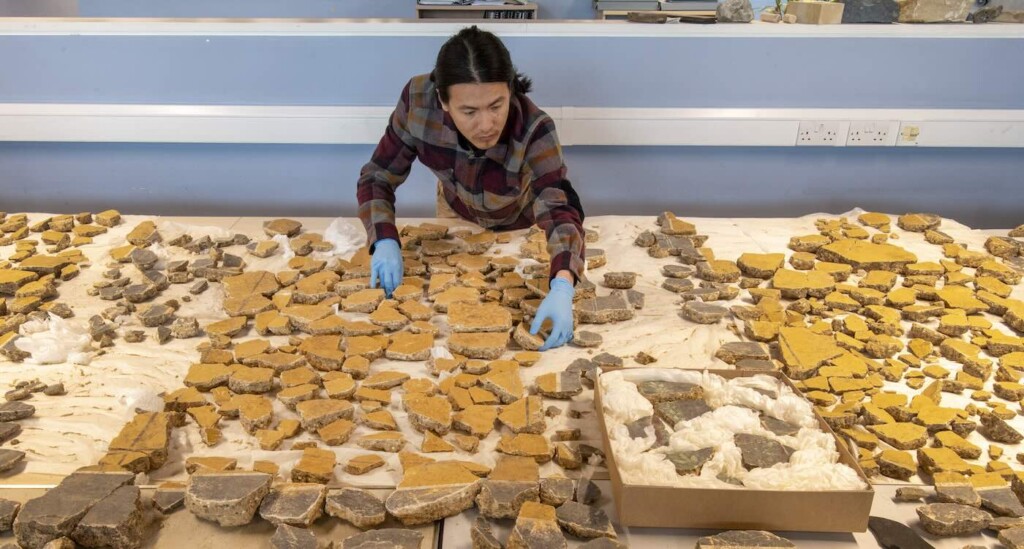In the heart of London, a groundbreaking discovery has unveiled a vibrant glimpse into the past, showcasing the artistic flair of ancient Roman society. This enchanting tale revolves around the unearthing of exquisite painted wall plaster, which reconnects us to a bustling world that thrived nearly two millennia ago.

During a recent excavation at a London development site, archaeologists uncovered one of the most significant collections of painted Roman wall plaster discovered in the city. This stunning plaster once adorned a lavish Roman building in Southwark, a place of wealth and artistry before it was lost to time, with destruction occurring before 200 CE.
As the archaeologists began to sift through the remnants of history, they were greeted with more than just fragments. Among the findings, they discovered a painter’s rare signature and intriguing ancient graffiti inscribed in the Greek alphabet—testaments to the vibrant lives that once filled these spaces.
Led by the experts at the Museum of London Archaeology (MOLA), this expedition showcased the remnants of a grand Roman presence in Britain. However, the magnitude of the discovery was initially hidden; the beautifully decorated plaster had been carelessly discarded in a large pit, shattered into thousands of delicate pieces. This destruction, it turned out, was not the result of modern-day construction but rather of ancient Roman demolition long ago.
For three painstaking months, Senior Building Material Specialist Han Li worked diligently, laying out each fragment and meticulously reassembling the intricate designs. It felt as if he was piecing together a magnificent jigsaw puzzle, one that had lost its edges and colors through the ages.
“This moment is truly unique,” Han shared, his excitement palpable. “I felt a mix of nervousness and joy as I began uncovering these beautiful fragments. Many were incredibly delicate, and the way the pieces had been mixed during demolition only added to the complexity.”
What emerged was a splendid array of panel designs, boasting bright yellow backgrounds embellished with striking black accents, depicting birds, fruit, flowers, and serene lyres. While panels were a common aspect of Roman decoration, the vibrant yellow was an exceptional discovery, rarely seen and mostly identified in opulent locations like the Fishbourne Roman Palace.
Moreover, these artists drew inspiration from various parts of the Roman Empire, echoing styles found in cities like Xanten and Cologne, as well as Lyon. Some of the pieces evocatively mimicked high-status wall tiles, including majestic representations of red Egyptian porphyry and yellow marble, creating a rich tapestry of color and history.
In an exhilarating twist, Han Li and his team also found the earliest known painter’s signature in Britain—an extraordinary find that signified the pride and identity of the creators. This signature was encased in a decorative carving, reading ‘FECIT,’ Latin for “has made this.” Regrettably, the fragment was damaged, leaving the painter’s name a mystery, lost to the sands of time.
Adding a layer of rich context, the plaster bore ancient graffiti, including an almost complete Greek alphabet, providing a peek into the everyday lives of the building’s former visitors. This recent discovery marks the only known example of this type of inscription in Roman Britain, suggesting it may have served as a practical reference or tally, crafted by a skilled hand.
With ongoing restoration work, Han Li and his dedicated colleagues continue their exploration and analysis of these captivating pieces, comparing them to other artworks from the Roman era. The results will be preserved, archived, and potentially displayed for future generations to appreciate the beauty of this ancient artistry.
“I was truly fortunate to have my colleagues’ expertise in piecing together this immense puzzle,” reflected Han, acknowledging the teamwork that made such discoveries possible. “What we’ve unveiled is a glimpse of the decorative art that would have graced even the eyes of those inhabiting London during the late Roman period.”
SHARE This Enriching Discovery Right From The Heart Of London…
If you would like to see similar good news stories click here & Share this to brighten someone’s day.





